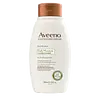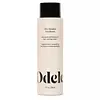What's inside
What's inside
 Key Ingredients
Key Ingredients

No key ingredients
 Benefits
Benefits

 Concerns
Concerns

 Ingredients Side-by-side
Ingredients Side-by-side

Colloidal Oatmeal Extract
HumectantCetyl Alcohol
EmollientCetearyl Alcohol
EmollientBehentrimonium Chloride
PreservativeGlycerin
HumectantSteareth-20
CleansingPPG-3 Benzyl Ether Myristate
EmollientHydrolyzed Milk Protein
Skin ConditioningPrunus Amygdalus Dulcis Seed Extract
Skin ConditioningAmodimethicone
Polyquaternium-47
Skin ConditioningPolyquaternium-37
PPG-1 Trideceth-6
Skin ConditioningPropylene Glycol Dicaprylate/Dicaprate
EmollientWater
Skin ConditioningIsopropyl Alcohol
SolventDisodium EDTA
Citric Acid
BufferingSodium Hydroxide
BufferingSodium Benzoate
MaskingParfum
MaskingColloidal Oatmeal Extract, Cetyl Alcohol, Cetearyl Alcohol, Behentrimonium Chloride, Glycerin, Steareth-20, PPG-3 Benzyl Ether Myristate, Hydrolyzed Milk Protein, Prunus Amygdalus Dulcis Seed Extract, Amodimethicone, Polyquaternium-47, Polyquaternium-37, PPG-1 Trideceth-6, Propylene Glycol Dicaprylate/Dicaprate, Water, Isopropyl Alcohol, Disodium EDTA, Citric Acid, Sodium Hydroxide, Sodium Benzoate, Parfum
Water
Skin ConditioningCetearyl Alcohol
EmollientStearyl Alcohol
EmollientGlycerin
HumectantAmodimethicone
Behentrimonium Chloride
PreservativeAvena Sativa Kernel Extract
AbrasiveAmaranthus Caudatus Seed Extract
Skin ConditioningHydrolyzed Rice Protein
Skin ConditioningHydroxyethylcellulose
Emulsion StabilisingTetrasodium Glutamate Diacetate
Diheptyl Succinate
EmollientCapryloyl Glycerin/Sebacic Acid Copolymer
Skin ConditioningCetrimonium Chloride
AntimicrobialLinoleamidopropyl Pg-Dimonium Chloride Phosphate Dimethicone
Isopropyl Alcohol
SolventTrideceth-3
EmulsifyingTrideceth-15
EmulsifyingAcetic Acid
BufferingEthylhexylglycerin
Skin ConditioningPhenoxyethanol
PreservativeSodium Hydroxide
BufferingCitric Acid
BufferingWater, Cetearyl Alcohol, Stearyl Alcohol, Glycerin, Amodimethicone, Behentrimonium Chloride, Avena Sativa Kernel Extract, Amaranthus Caudatus Seed Extract, Hydrolyzed Rice Protein, Hydroxyethylcellulose, Tetrasodium Glutamate Diacetate, Diheptyl Succinate, Capryloyl Glycerin/Sebacic Acid Copolymer, Cetrimonium Chloride, Linoleamidopropyl Pg-Dimonium Chloride Phosphate Dimethicone, Isopropyl Alcohol, Trideceth-3, Trideceth-15, Acetic Acid, Ethylhexylglycerin, Phenoxyethanol, Sodium Hydroxide, Citric Acid
Ingredients Explained
These ingredients are found in both products.
Ingredients higher up in an ingredient list are typically present in a larger amount.
This water-soluble silicone is used for its hydrating and softening properties. It is used to add a silky feel to skincare products and has great benefits for haircare.
In haircare, this ingredient:
- Adds shine
- Protects color
- Offers thermal protection
- Boosts hair strength
- Does not build up as easily
This ingredient is a preservative and often used for it's anti-static properties. You'll most likely see this ingredient in hair conditioners.
It does not cause irritation or sensitization in leave-on products at 1-5%.
Cetearyl alcohol is a mixture of two fatty alcohols: cetyl alcohol and stearyl alcohol. It is mainly used as an emulsifier. Emulsifiers help prevent the separation of oils and products. Due to its composition, it can also be used to thicken a product or help create foam.
Cetearyl alcohol is an emollient. Emollients help soothe and hydrate the skin by trapping moisture.
Studies show Cetearyl alcohol is non-toxic and non-irritating. The FDA allows products labeled "alcohol-free" to have fatty alcohols.
This ingredient is usually derived from plant oils such as palm, vegetable, or coconut oils. There is debate on whether this ingredient will cause acne.
Due to the fatty acid base, this ingredient may not be Malassezia folliculitis safe.
Learn more about Cetearyl AlcoholCitric Acid is an alpha hydroxy acid (AHA) naturally found in citrus fruits like oranges, lemons, and limes.
Like other AHAs, citric acid can exfoliate skin by breaking down the bonds that hold dead skin cells together. This helps reveal smoother and brighter skin underneath.
However, this exfoliating effect only happens at high concentrations (20%) which can be hard to find in cosmetic products.
Due to this, citric acid is usually included in small amounts as a pH adjuster. This helps keep products slightly more acidic and compatible with skin's natural pH.
In skincare formulas, citric acid can:
While it can provide some skin benefits, research shows lactic acid and glycolic acid are generally more effective and less irritating exfoliants.
Most citric acid used in skincare today is made by fermenting sugars (usually from molasses). This synthetic version is identical to the natural citrus form but easier to stabilize and use in formulations.
Read more about some other popular AHA's here:
Learn more about Citric AcidGlycerin is already naturally found in your skin. It helps moisturize and protect your skin.
A study from 2016 found glycerin to be more effective as a humectant than AHAs and hyaluronic acid.
As a humectant, it helps the skin stay hydrated by pulling moisture to your skin. The low molecular weight of glycerin allows it to pull moisture into the deeper layers of your skin.
Hydrated skin improves your skin barrier; Your skin barrier helps protect against irritants and bacteria.
Glycerin has also been found to have antimicrobial and antiviral properties. Due to these properties, glycerin is often used in wound and burn treatments.
In cosmetics, glycerin is usually derived from plants such as soybean or palm. However, it can also be sourced from animals, such as tallow or animal fat.
This ingredient is organic, colorless, odorless, and non-toxic.
Glycerin is the name for this ingredient in American English. British English uses Glycerol/Glycerine.
Learn more about GlycerinIsopropyl Alcohol is more commonly known as rubbing alcohol. It is most commonly used as a solvent, meaning it helps other ingredients dissolve.
This ingredient is an astringent alcohol. Astringent alcohols may also irritate skin as they high amounts may strip away your skin's natural oils.
Other types of astringent alcohols include:
According to the National Rosacea Society based in the US, you should be mindful of products with these alcohols in the top half of ingredients.
Any type of sanitizing product will have high amounts of alcohol to help kill bacteria and viruses.
Learn more about Isopropyl AlcoholSodium Hydroxide is also known as lye or caustic soda. It is used to adjust the pH of products; many ingredients require a specific pH to be effective.
In small amounts, sodium hydroxide is considered safe to use. However, large amounts may cause chemical burns due to its high alkaline.
Your skin has a natural pH and acid mantle. This acid mantle helps prevent harmful bacteria from breaking through. The acid mantle also helps keep your skin hydrated.
"Alkaline" refers to a high pH level. A low pH level would be considered acidic.
Learn more about Sodium HydroxideWater. It's the most common cosmetic ingredient of all. You'll usually see it at the top of ingredient lists, meaning that it makes up the largest part of the product.
So why is it so popular? Water most often acts as a solvent - this means that it helps dissolve other ingredients into the formulation.
You'll also recognize water as that liquid we all need to stay alive. If you see this, drink a glass of water. Stay hydrated!
Learn more about Water